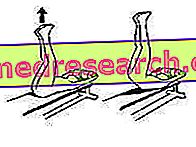By Dr. Antonino Bianco
"In the morning you wake up 2 sets of crunches x 25 rip"
The abdominals are muscles of great interest among the fitness-goers. From a biomechanical point of view, the muscles of the abdomen (rectus of the abdomen, external oblique, internal oblique and transverse of the abdomen) lower the ribs and determine the flexion of the spine in its thoracic and lumbar tract. The action of the oblique abdominal muscles also stabilizes the vertebral column, while the contraction of the transverse muscle limits the compression of the lumbar inter-vertebral discs, two phenomena that appear to be precious to safeguard the back during physical activity, especially in bodybuilding, where the vertebral column is subjected to considerable compression loads.
The main exercises to train the free-body abdomen muscles are:
| The crunch | Reverse crunch or leg raises | The crunch with torsion |
 |  |  |
In the fitness field it is usual to say that in the crunch a flexion of the chest is performed on the pelvis, while in the leg raises a pelvic flexion is performed on the chest. Whether you perform specific exercises for the rectus abdominal muscle (the famous high and low abdomen), which for the oblique muscles, the phase of maximum muscle shortening can be reached only if the diaphragm is completely raised, that is, only if the lungs have been properly emptied of the contained air.
THE MOST COMMON BREATHING ERRORS
Forfeit too much air during inspiration (passive phase of movement): due to the less fluidity of the subsequent expiration phase, as performed under stress, it will not be time to empty the lungs before the end of the active phase of the exercise; consequently the diaphragm will not be fully raised and the abdominal shortening, thus hindered, will not be complete.
Hold the air in the lungs until the end of the active repetition phase: the diaphragm will remain lowered and, opposing the closure of the trunk, will hinder the abdominal muscles that will not be able to correctly perform their shortening phase, possibly distributing on the muscles of the legs and pelvis (ilo psoas, sartorius and rectum of the femur) much of the work in the active phase of the exercise:
"An empty bag folds more easily and more than one full".
For a correct execution it is good that the lumbar region of the spine and the buttocks are in contact with the ground and that the lower limb is semi-folded in order to limit the intervention of the flexor muscles of the thigh. The number of repetitions should not exceed 15 rips for the strengthening (from 3 to 6 series), while to tone and develop muscular resistance you can go even further (from 3 to 6 series for a maximum of 40 rip.), naturally it must be a progressive and gradual increase, based on the characteristics physical and on the degree of subjective preparation; the consultancy of qualified personnel (Doctor of Motor Sciences) is therefore of fundamental importance to obtain the best results in complete safety.
Very often the training of the abdominals is inserted in the last places of the daily workouts, so it happens that at the end of a workout there is less desire and strength to work on it, an advice: " train them at home too".
In the morning just wake up 2 sets of crunches x 25 rip. with 60 "of rec. (Monday-Wednesday-Friday).
If you manage to integrate the normal fitness room activity with abdominal exercises (at home) you will get extraordinary results in just two months.



